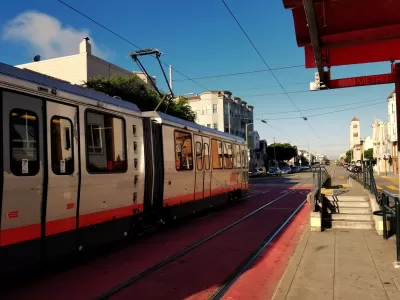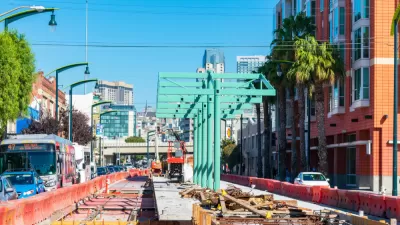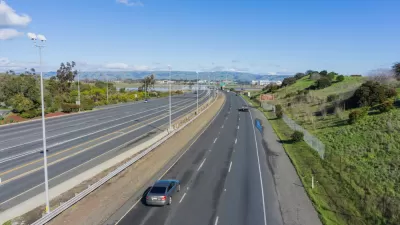The light rail line was supposed to improve transit to less accessible parts of the city, but service so far has been disappointing.

Rachel Swan reports on the T-Third Street Muni light rail line in San Francisco. The line runs through communities along the eastern side of the city, many of which are growing quickly. It was pitched as an alternative to local bus service and a quick and efficient way to move people from some of the city’s more far-flung neighborhoods.
But soon after the line opened in 2007, it was plagued with delays that have continued:
The T line’s problems appear to stem from its design. It hits about 60 intersections looping from Sunnydale to the Folsom portal, where it travels underground to Embarcadero Station and then changes signs to become the K-Ingleside. Most of those intersections have traffic signals that don’t always sync up to give trains priority over other vehicles.
In addition, says Swan, trains are slowed down by cars making illegal left-hand turns and on parts of route where trains share roads crowded with vehicle traffic.
Plans to improve service include using software to help trains get through lights and intersections more easily, addressing problem points on the route, and increasing train capacity by adding additional cars.
With the rapid growth in development in neighborhoods along the route and the demand in ridership that will result, whether these changes will fix the T line’s problems remains to be seen. In addition, residents say 23rd Street in the Dogpatch neighborhood marks the end of gentrification in the area, and they wonder if service improvements will benefit lower-income and more isolated communities to the south.
“Even so, politicians and transit officials still champion the T as a great social equalizer, saying it could pump business into the city’s most neglected neighborhoods and give those residents a quick link to the downtown core,” says Swan.
FULL STORY: The T line has never lived up to its promise. Coming upgrades may not be enough to help

Alabama: Trump Terminates Settlements for Black Communities Harmed By Raw Sewage
Trump deemed the landmark civil rights agreement “illegal DEI and environmental justice policy.”

Planetizen Federal Action Tracker
A weekly monitor of how Trump’s orders and actions are impacting planners and planning in America.

The 120 Year Old Tiny Home Villages That Sheltered San Francisco’s Earthquake Refugees
More than a century ago, San Francisco mobilized to house thousands of residents displaced by the 1906 earthquake. Could their strategy offer a model for the present?

Ken Jennings Launches Transit Web Series
The Jeopardy champ wants you to ride public transit.

BLM To Rescind Public Lands Rule
The change will downgrade conservation, once again putting federal land at risk for mining and other extractive uses.

Indy Neighborhood Group Builds Temporary Multi-Use Path
Community members, aided in part by funding from the city, repurposed a vehicle lane to create a protected bike and pedestrian path for the summer season.
Urban Design for Planners 1: Software Tools
This six-course series explores essential urban design concepts using open source software and equips planners with the tools they need to participate fully in the urban design process.
Planning for Universal Design
Learn the tools for implementing Universal Design in planning regulations.
Clanton & Associates, Inc.
Jessamine County Fiscal Court
Institute for Housing and Urban Development Studies (IHS)
City of Grandview
Harvard GSD Executive Education
Toledo-Lucas County Plan Commissions
Salt Lake City
NYU Wagner Graduate School of Public Service





























